Soltau-Lüneburg Training Area
This article includes a improve this article by introducing more precise citations. (April 2015) ) |

The Soltau-Lüneburg Training Area (SLTA) was a British and Canadian
History
In spite of the establishment of the

After the Second World War, Canadian forces and units of the
In the wake of the integration of West Germany into the West, the country joined NATO in 1955, whereupon the occupation statute ceased to operate. The Paris Peace Treaties contained a new regulation for the presence of foreign troops in West Germany, which henceforth became known as "Sending States' Forces", stationed in Germany to help defend the country against possible invasion by the Soviet-controlled Warsaw Pact. In 1956 the Canadians largely stopped exercising in this area. That year the British withdrew from an area of 600 hectares near Haverbeck, after major protests by the locals.
Agreement
On 3 August 1959 the Federal Republic of Germany, Canada and the United Kingdom signed a special agreement in Bonn permitting exercises in the area of Soltau-Lüneburg in order to be able to train to defend Germany in the event of attack during the
The agreement permitted stationed troops to conduct exercises all-year-round within the specified area. Villages and farmsteads were not to be used as military objectives and armoured vehicles could not move on Sundays or public holidays.
Location
The Soltau-Lüneburg Agreement designated an area, 40 km long and 10 km wide, between the towns of
Impact
Around 1,800 landowners were required, under the agreement, to make their property available for military purposes. With over 1,600 hectares, the Nature Reserve Society was one of the landowners affected and they refused to accept the Soltau-Lüneburg Agreement from the outset, although their opposition came to nothing. Another 1,600 hectares belonged to private landowners. In 1970, several landowners were allowed to return their estates to agricultural use. In the mid-1970s, the VNP unsuccessfully sued, citing the unconstitutionality of the agreement before the county court in Lüneburg.
As a result of armoured vehicle training, the heathland of the red areas increasingly resembled a desert. The areas were not, however, placed out-of-bounds like a normal military training area and the public could enter them. In a few cases there were accidents as a result of visitors tampering with training munitions. No live firing was permitted in the area, however.
During the 1970s, an average of 1,500 armoured vehicles and 30,000 soldiers exercised in the training area each year under the terms of the agreement. As a result, traffic on the local roads was heavy due to troop movements and there was an increased risk of accidents. The local population had to put up with noise, dust and vibration. In addition, the harvests were sometimes affected and roads damaged by the movement of heavy military loads. However, significant compensation for the damage caused was regularly paid by both the British and German governments in accordance with the SOFA.
Protests
In
End of the Agreement
In 1989, at the end of the Cold War, the Soltau-Lüneburg Agreement was renegotiated by defence ministers, Gerhard Stoltenberg, and Tom King, in order to reduce the impact of exercises on the local population. In 1990, a break in training of several weeks was agreed during the time when the heath was in bloom during the peak tourist period of August and September. In addition no tanks were permitted to use the red areas on Sundays and public holidays. Villages were given a 400 metre wide buffer zone from armoured exercises and tanks were not permitted to drive through them at night.
After German reunification, the two defence ministers, Stoltenberg and King, reached an agreement on 17 October 1991 for the cessation of training in the heath. On 31 July 1994 the Soltau-Lüneburg Agreement ran out and the last red areas were returned to the VNP. They have subsequently restored the areas with the assistance of the Federation.
Literature
- Reports by the NNA: Einer trage des Anderen Last - 12.782 Tage Soltau-Lüneburg-Abkommen, 4th year/1993, special issue
External links
- Military use of the Lüneburg Heath Nature Reserve under the Soltau-Lüneburg Accord... Report and references on the nature reserve's website
- Alles erlaubt ("Everything is permitted"), article in SPIEGEL dated 11 October 1976
- Feldköken mit Rum, article in SPIEGEL dated 12 July 1971
